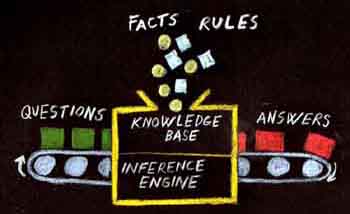|
||||||||||||||||||||||||||||||||||||||||||||||||||||||||||||||||||||||||||||||||||||||||||||||||||||
| The part of an "intelligent system" which deals with knowledge representation is usually separate from the part which deals with "reasoning". The knowledge representation part is referred to as the knowledge base, while the reasoning part is referred to as the inference engine. A knowledge base (KB) is a database of knowledge, and knowledge in Pro/3 is sub-divided into facts and rules. The knowledge is stored in a format which enables the inference engine to reason with it, for the purpose of answering questions. | ||||||||||||||||||||||||||||||||||||||||||||||||||||||||||||||||||||||||||||||||||||||||||||||||||||
|
||||||||||||||||||||||||||||||||||||||||||||||||||||||||||||||||||||||||||||||||||||||||||||||||||||
| The green classifications are stored in a format which can be interpreted by a PROLOG-type inference engine directly. The pink classifications are using a similar format - superficially, but the interpretation of the knowledge either uses extensive add-ons to the basic inference logic (which is the case for set-rules), or a different inference engine (which is the case for inexact rules). (The basic inference engine, the add-ons and the inexact rule inference engine are all integrated into one overall inference system). | ||||||||||||||||||||||||||||||||||||||||||||||||||||||||||||||||||||||||||||||||||||||||||||||||||||
|
The basic storage unit on a technical level is a record. One "piece of knowledge" (one fact, one rule) is stored in one record. However, there are a few exceptions:
The record-structure is the same for all types of records. |
||||||||||||||||||||||||||||||||||||||||||||||||||||||||||||||||||||||||||||||||||||||||||||||||||||
|
The knowledge base includes different aspects of knowledge, that is, both meta-data (which describes other knowledge), as well as "application" knowledge being described by the meta-data. There is no physical segregation between these two types of knowledge, i.e. exactly the same representation structures are used. The term meta data is usually used (rather than meta knowledge). This is not a particularly important distinction, but note that meta-knowledge only includes factual knowledge (there are no meta-rules!). Knowledge which is not meta-knowledge is usually referred to as application knowledge. There are actually three levels of knowledge according to this structure: application knowledge, the application meta-model and at the bottom Pro/3's own built-in meta model. Application meta model data is often referred to as structure knowledge since it defines the structure of the application knowledge. |
||||||||||||||||||||||||||||||||||||||||||||||||||||||||||||||||||||||||||||||||||||||||||||||||||||
|
Example
1. Application knowledge
2. Application meta knowledge
3. Pro/3 meta model
|
||||||||||||||||||||||||||||||||||||||||||||||||||||||||||||||||||||||||||||||||||||||||||||||||||||
| The inclusion of the meta model level in the KB might seem a little bit over the top, it has the advantage that queries and reporting of meta data can be carried out with exactly the same facilities as is used for application data. The meta model is loaded from the standard knowledge file PRO3-B-META.3PR. While the inclusion of the meta model as factual knowledge in the KB suggests that it can be modified to meet special requirements, then this is not so. The Pro/3 meta model must not be changed as its structure also is built into to the system logic. | ||||||||||||||||||||||||||||||||||||||||||||||||||||||||||||||||||||||||||||||||||||||||||||||||||||
|
The KB also includes another set of meta data - the terminology. The terminology is a mapping between natural language names and internal format names. |
||||||||||||||||||||||||||||||||||||||||||||||||||||||||||||||||||||||||||||||||||||||||||||||||||||
|
||||||||||||||||||||||||||||||||||||||||||||||||||||||||||||||||||||||||||||||||||||||||||||||||||||
| The blue classifications are under Pro/3's administration, while the pink classifications are under the KE's administration. A terminology consists of syntagms and synonyms, while a sentence model consists of predicate types, entity types, data element types and function declarations. | ||||||||||||||||||||||||||||||||||||||||||||||||||||||||||||||||||||||||||||||||||||||||||||||||||||
|
Digging deeper into the knowledge base... |
||||||||||||||||||||||||||||||||||||||||||||||||||||||||||||||||||||||||||||||||||||||||||||||||||||
|
Database Internal Structure - Multi-KB configurations - Queries and Query Menus - Annotations - NL Interface - Knowledge Integrity - Internal Format Syntax |
||||||||||||||||||||||||||||||||||||||||||||||||||||||||||||||||||||||||||||||||||||||||||||||||||||
